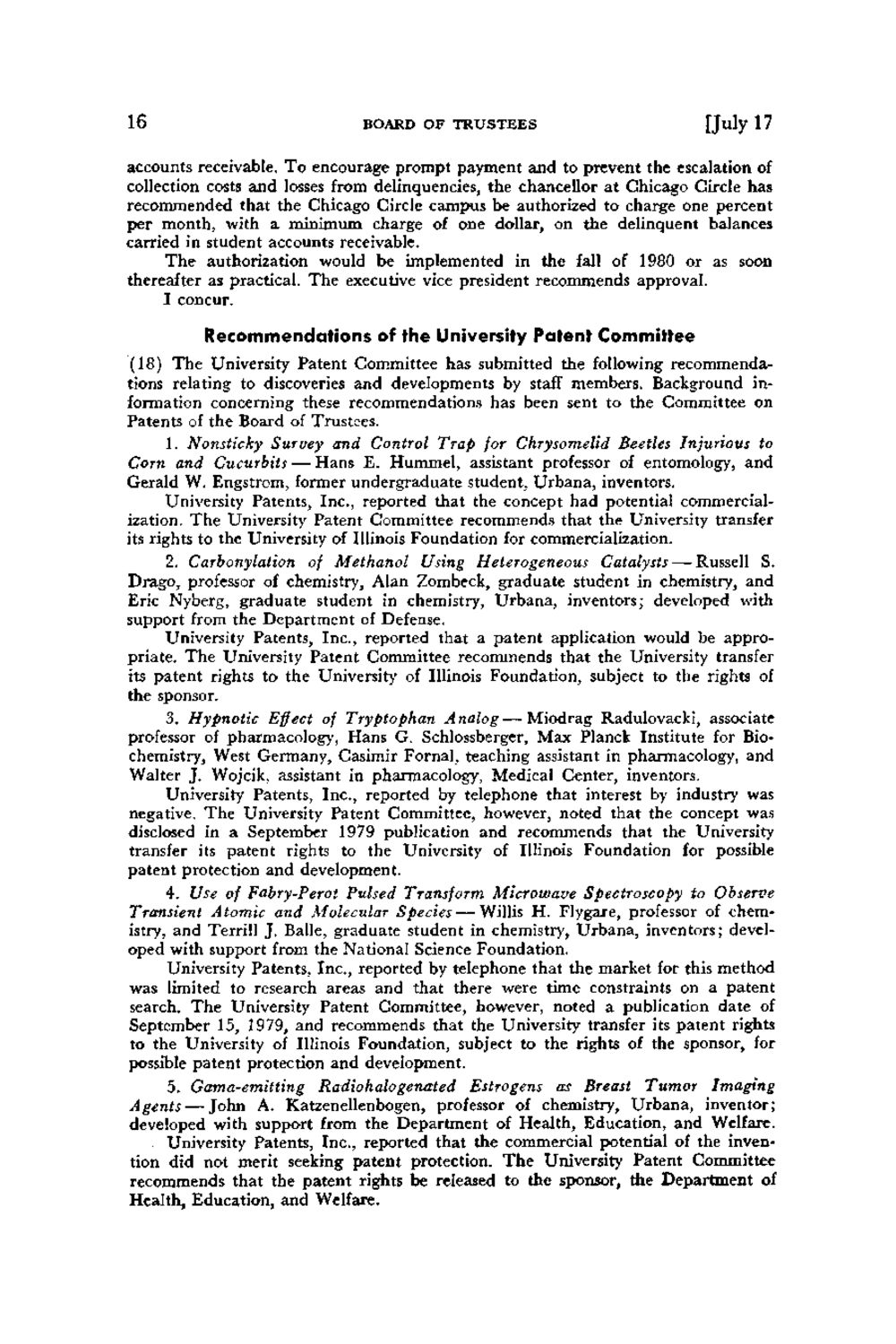| |
| |
Caption: Board of Trustees Minutes - 1982
This is a reduced-resolution page image for fast online browsing.

EXTRACTED TEXT FROM PAGE:
16 BOARD OF T R U S T E E S [July 17 accounts receivable. T o encourage prompt payment and to prevent the escalation of collection costs and losses from delinquencies, the chancellor at Chicago Circle has recommended that the Chicago Circle campus be authorized to charge one percent per month, with a minimum charge of one dollar, on the delinquent balances carried in student accounts receivable. T h e authorization would be implemented in the fall of 1980 or as soon thereafter as practical. The executive vice president recommends approval. I concur. Recommendations of the University Patent Committee (18) The University Patent Committee has submitted the following recommendations relating to discoveries and developments by staff members. Background information concerning these recommendations has been sent to the Committee on Patents of the Board of Trustees. 1. Nonsticky Survey and Control Trap for Chrysomelid Beetles Injurious to Corn and Cucurbits — Hans E. Hummel, assistant professor of entomology, and Gerald W. Engstrom, former undergraduate student, Urbana, inventors. University Patents, Inc., reported that the concept had potential commercialization. The University Patent Committee recommends that the University transfer its rights to the University of Illinois Foundation for commercialization. 2. Carbonylation of Methanol Using Heterogeneous Catalysts — Russell S. Drago, professor of chemistry, Alan Zombeck, graduate student in chemistry, and Eric Nyberg, graduate student in chemistry, Urbana, inventors; developed with support from the Department of Defense. University Patents, Inc., reported that a patent application would be appropriate. The University Patent Committee recommends that the University transfer its patent rights to the University of Illinois Foundation, subject to the rights of the sponsor. 3. Hypnotic Effect of Tryptophan Analog—Miodrag Radulovacki, associate professor of pharmacology, Hans G. Schlossberger, Max Planck Institute for Biochemistry, West Germany, Casimir Fornal, teaching assistant in pharmacology, and Walter J. Wojcik, assistant in pharmacology, Medical Center, inventors. University Patents, Inc., reported by telephone that interest by industry was negative. The University Patent Committee, however, noted that the concept was disclosed in a September 1979 publication and recommends that the University transfer its patent rights to the University of Illinois Foundation for possible patent protection and development. 4. Use of Fabry-Perot Pulsed Transform Microwave Spectroscopy to Observe Transient Atomic and Molecular Species — Willis H. Flygare, professor of chemistry, and Terrill J. Balle, graduate student in chemistry, Urbana, inventors; developed with support from the National Science Foundation. University Patents, Inc., reported by telephone that the market for this method was limited to research areas and that there were time constraints on a patent search. The University Patent Committee, however, noted a publication date of September 15, 1979, and recommends that the University transfer its patent rights to the University of Illinois Foundation, subject to the rights of the sponsor, for possible patent protection and development. 5. Gama-emitting Radiohalogenated Estrogens as Breast Tumor Imaging Agents—-John A. Katzenellenbogen, professor of chemistry, Urbana, inventor; developed with support from the Department of Health, Education, and Welfare. . University Patents, Inc., reported that the commercial potential of the invention did not merit seeking patent protection. The University Patent Committee recommends that the patent rights be released to the sponsor, the Department of Health, Education, and Welfare.
| |